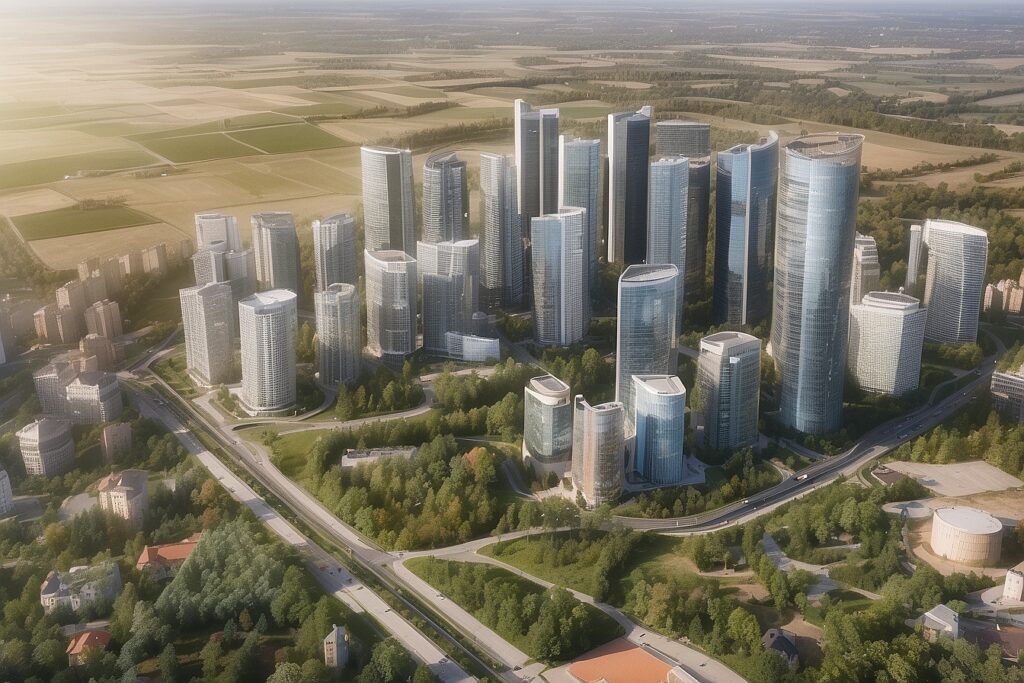The Evolving Landscape of Land Development in Poland: Insights from John Palmer, Deloitte Partner

John Palmer, Partner Associate in Real Estate Advisory at Deloitte Poland, recently engaged in a conversation with Property Forum regarding the dynamic shifts within Poland’s land development market and its growing appeal to foreign investors.
In contemplating the escalating significance of development site availability and the integration of land banking into the strategies of major manufacturers, logistics service providers, and other multinational corporations, Palmer illuminated critical insights.
As international enterprises delve into or expand across Central and Eastern Europe (CEE), their pursuit increasingly revolves around securing Build-to-Suit (BTS) structures tailored to their specific requirements and aligned with Environmental, Social, and Governance (ESG) standards. Palmer emphasized that the quest for suitable, de-risked development sites capable of accommodating such BTS facilities is paramount for these companies to align with their strategic objectives.
BTS transactions entail the construction of properties to be sold or leased, precisely tailored to the specifications of the tenant or buyer. While conventional logistic warehouses can sometimes be modified to suit occupiers’ needs, bespoke, stand-alone BTS solutions often emerge as the optimal choice to comprehensively address all business imperatives.
Palmer highlighted the burgeoning trend of production and supply nearshoring as a primary driver behind the heightened demand for BTS facilities among international entities in CEE. Nearshoring, which involves relocating production or supply closer to consumer markets, underscores the necessity for well-positioned and prepared development sites to accommodate these evolving operational dynamics.
Moreover, Palmer underscored the domestic market’s growing appetite for BTS solutions, where companies increasingly eschew distant locales in favor of proximate sites due to outdated, inefficient existing premises that fail to meet evolving ESG criteria.
In light of these imperatives, Palmer emphasized the critical role of de-risked development land sites capable of swiftly accommodating new, efficient BTS structures. Such sites serve as vital platforms for corporates and international entities as they pivot, relocate, and occupy facilities aligned with their and their clientele’s ESG mandates.
Given the scarcity of development sites in Western Europe, Palmer urged international companies to recognize the limited supply of BTS-ready sites in CEE and proactively secure and bank land to align with their strategic business imperatives. Swift action in this regard becomes instrumental in fulfilling their long-term objectives and sustaining competitive advantage amidst evolving market landscapes.
Assessing the State of Land Development Law in Poland: Streamlining Processes for Developers
In recent years, developers in Poland have voiced persistent concerns regarding the outdated and overly convoluted nature of land development laws. Administrative procedures often seem to stretch indefinitely, causing frustration and hindering progress. However, a closer examination reveals a more nuanced picture of the situation.
Polish legislation governing land development, despite criticisms, demonstrates a level of efficiency and functionality that distinguishes it from counterparts in Western Europe. Unlike the bureaucratic mazes encountered elsewhere, the permitting process in Poland tends to be less protracted, offering a comparative advantage to developers.
Central to this regulatory framework is the Environmental Impact Permit (EIP), which serves as the linchpin in de-risking potential development sites. Once secured for a specific project, subsequent Building Permits become more of a procedural formality.
At the heart of the EIP application lies a comprehensive assessment of the proposed development’s potential impact on the surrounding environment. From the influx of people to waste management, traffic flow to utility provisions, every facet of the project’s footprint is meticulously evaluated. Securing a green light from all relevant public authorities and utility providers is imperative for obtaining the EIP, signifying a crucial milestone in the development process.
Moreover, the EIP process serves as a proactive mechanism for addressing environmental concerns from the outset. By requiring developers to assess and mitigate potential impacts upfront, the system promotes sustainable development practices and minimizes conflicts down the line.
However, despite the relative efficiency of the EIP process, challenges persist within the broader landscape of land development in Poland. One recurring issue is the perception of administrative complexity, which can vary significantly depending on the locality and specific project parameters. Navigating through layers of regulatory requirements and bureaucratic hurdles remains a daunting task for many developers, particularly those unfamiliar with the intricacies of Polish law.
Furthermore, while the EIP streamlines certain aspects of the permitting process, other regulatory hurdles may still contribute to project delays and uncertainties. Issues such as zoning restrictions, land use designations, and heritage preservation requirements can complicate development initiatives, leading to prolonged negotiations and potential setbacks.
Addressing these challenges requires a multifaceted approach that prioritizes transparency, efficiency, and stakeholder engagement. Simplifying administrative procedures, enhancing coordination among regulatory bodies, and providing clearer guidelines for developers are essential steps toward fostering a more conducive environment for land development in Poland.
Moreover, leveraging digital technologies and data-driven solutions can streamline processes, reduce paperwork, and enhance decision-making across the board. By embracing innovation and adopting best practices from around the globe, Poland can further enhance its competitiveness in the realm of land development while safeguarding environmental integrity and promoting sustainable growth.
Is the focus on development requirements of corporations increasingly shifting towards Central and Eastern Europe (CEE)?
A noticeable trend towards CEE relocation is particularly evident among international companies in sectors such as machinery, automotive, electronics, electricals, and consumer goods, including clothing.
The evolving global landscape is emphasizing the inefficiencies of international manufacturing companies, leading to a heightened interest in CEE. Corporations are increasingly considering nearshoring to CEE to enhance their supply chain resilience, aiming for a more sustainable global footprint. A survey by ABB in 2022 revealed that 74% of European businesses are planning to nearshore their operations.
The current global supply chain, characterized by just-in-time (JIT) systems and trade agreements organized by the World Trade Organization, is proving to be inefficient and fragile. Consequently, international companies are moving swiftly to reduce dependency on Asia and relocate their production facilities closer to their end customers.
Cost plays a pivotal role in location decisions. The once significant wage savings offered by Asian offshoring compared to CEE have diminished. Additionally, shipping costs have surged, especially amid the ongoing conflict in the Middle East, leading to longer alternative routes into Europe.
In addition to cost considerations, corporations are increasingly focusing on sustainability and the social impact of their operations to align with strategic, funding, and legislative requirements. This entails reducing the carbon footprint of products by shortening transport routes and building new, efficient facilities in optimal locations, replacing older structures constructed before the ESG (Environmental, Social, and Governance) era.
The surge in nearshoring is evident from the increased mentions of nearshoring in 2023 earnings calls compared to previous years, as reported by HSBC. Furthermore, foreign companies pledged over USD 82 billion to manufacturing projects in 15 nearshoring destinations in CEE and North Africa between 2022 and 2023, marking a 62% increase compared to pre-pandemic years.
It’s noteworthy that according to Bloomberg (February 2024), new foreign direct investment in China plummeted to a three-year low, with countries like Japan, Taiwan, and Korea reducing investments due to geopolitical tensions and higher interest rates elsewhere.
For instance, manufacturing investment in Poland surged to USD 13.85 billion in 2022-23 compared to USD 5.65 billion in 2020-2021, as reported by FDI intelligence. Notable investments include Intel’s construction of a new semiconductor assembly and test facility near Wrocław and Volkswagen’s ongoing expansion of their van production plant in Września near Poznań.
How crucial is it for occupiers to acquire derisked sites with thorough due diligence and zoning in place?
Acquiring derisked sites is imperative for occupiers to mitigate timing and building deliverability risks. Developers with local expertise have the opportunity to develop and deliver permitted sites after comprehensive legal and technical due diligence, aligning with corporate timelines.
Manufacturers often prefer funding and owning their Build-to-Suit facilities, which may not align with the requirements of traded developers. However, corporations can engage developers under Development Management Agreements (DMA) to build facilities according to their specifications and later explore sale and leaseback options.
For large manufacturers, logistic service providers, or other global corporations, ideal sites should facilitate the establishment of operational complexes within 18/24 months, ensuring they are derisked in terms of legal and technical due diligence and possess necessary environmental permits.
Additionally, these sites should have zoning for logistics and light production, allow for automation towers, 24-hour operations, production processes such as painting or welding, installation of PV panels, accommodate noise from production and truck movements, and provide adequate utilities and infrastructure.
Moreover, these sites should be located in preferred micro-locations with access to qualified workers, public transport, and rail freight terminals, ideally within Special Economic Zones offering incentive possibilities.
Is the complexity and timing of obtaining permits increasing considering ESG factors?
The complexity of obtaining permits is rising as stakeholders increasingly prioritize ESG factors in building developments. Developers, funders, and corporates are embracing responsible investing, necessitating high-level expertise to navigate permitting processes for new buildings.
Society, regulators, customers, and stakeholders are placing greater emphasis on sustainability, particularly in high-emission sectors like manufacturing and foreign direct investment. Policies and regulations encourage companies to integrate sustainability into their operations and disclose ESG performance.
Initiatives like the Carbon Border Adjustment Mechanism (CBAM) and EU Taxonomy compel companies to adopt sustainable practices. CBAM, effective from 2026, requires importers to pay for certificates corresponding to the carbon footprint of goods imported into the EU. EU Taxonomy classifies environmentally sustainable economic activities, with companies mandated to disclose this information in non-financial statements or annual sustainability reports.
New facilities must align with corporate strategies by fostering employee well-being, incorporating ecological specifications, utilizing renewable energy sources like photovoltaic panels, and minimizing carbon footprint. Certifications like BREEAM New Construction are increasingly sought after, along with the adoption of heat pumps to reduce reliance on gas.
What advantages does Poland offer for large Foreign Direct Investors, and what incentives are available?
Poland presents significant advantages for Foreign Direct Investors (FDIs) seeking to establish high-standard, ESG-oriented facilities within feasible timelines, facilitated by experienced developers and contractors.
Development sites in Poland offer appropriate zoning, services, and utilities to accommodate large investments, with the country’s geography enabling corporations to find suitable locations to serve their consumer and client base.
Government assistance in Central and Eastern Europe includes cash grants and tax incentives for capital expenditures (CAPEX) and job creation. In Poland, incentives can reach up to 50%, with aid disbursed in various forms such as Corporate Income Tax (CIT) exemptions, government grants, or EU-funded grants or loans.
Additionally, countries in the CEE region benefit from EU funds, providing further support for R&D, innovation, and environmental initiatives such as intermodal rail terminals aimed at reducing environmental impact.



